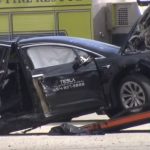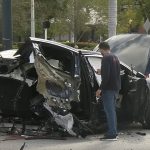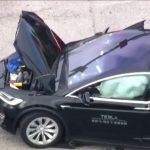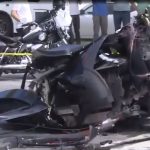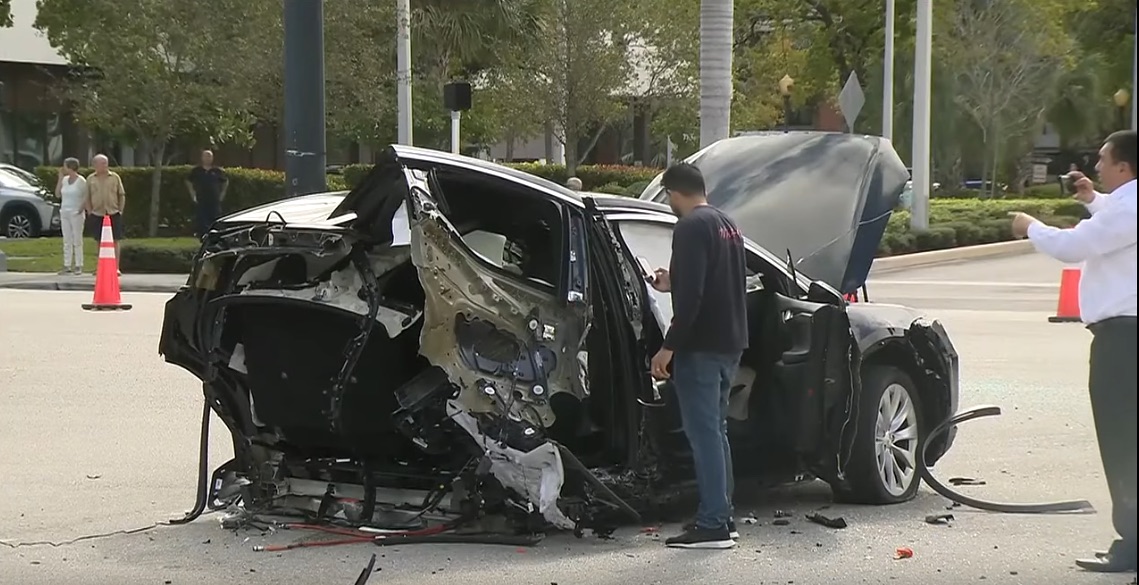
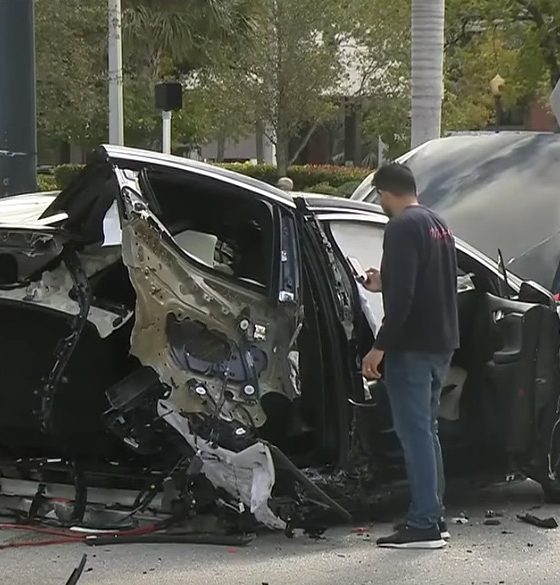
News
Tesla Model X splits in half after blindsided by Nissan GT-R, Tesla driver walks away unscathed
A serious car crash in Hallandale Beach, Florida left a Tesla Model X split in two after a Nissan GT-R alleged ran a red light before slamming into the all-electric SUV at high speed. The driver of the Model X walked away with a minor injury to his leg while the occupants of the other vehicle were brought to nearby hospitals for treatment and are expected to recover.
The driver of the Model X was identified as Jose Diaz who was seen counting his blessings moments after walking away from the incident. In a brief phone interview with 7News Miami, Diaz narrated that the Nissan came so fast that he didn’t even see it and that he just felt the bang.
Eyewitnesses to the scene recall seeing the white Nissan GT-R running through a red light at the intersection of Hallandale Beach Boulevard and Three Islands Boulevard before careening into the rear section of the Tesla Model X.
“I went over to help the guy in the white car, because the car had a lot of smoke, and I thought it was going to blow. He came out unscathed, and he was kissing the floor. It was a little blood coming from his nose, and he said, ‘Oh, I just wanna see my girl,’” said Tony Peart, a witness who approached to help the Tesla driver seconds after the wreck.
- Tesla Model X Florida car crash (Source: 7News Miami)
- Tesla Model X sheers in half after high speed crash (WPLG Local 10 | YouTube)
- Tesla Model X Florida car crash (Source: 7News Miami)
- Tesla Model X Florida car crash (Source: 7News Miami)
While it’s unfortunate to read about serious vehicular accidents, those involving a Tesla put into spotlight the all-electric carmaker’s award-winning safety features. It is very common to see SUVs involved in rollovers when involved in side-impact crashes because of their high center of gravity, but the opposite is true for Tesla vehicles and the Model X. With its low-mounted skateboard design battery pack, the center of gravity is far lower than traditional combustion engine cars, making it virtually impossible to roll over in high-speed crash testing.
The battery pack outer casing also serves as an extra layer of structural rigidity for the vehicle. Combined with a hybrid of ultra-high-strength materials, and large crumple zones that absorb energy to protect occupants from harm, and it’s no wonder that Tesla owners have touted never buying another car other than a Tesla.
“I waited 4 years for this one and would wait 4 more if that is what it took to protect my family like this” recalls one Model X owner after his all-electric SUV saved his life and the lives of his family after being involved in a horrific crash.
The Tesla Model X was awarded a 5-star safety rating in every category by the National Highway Traffic Safety Administration since its debut. Last December, the Model X was a standout in its class for earning the highest overall rating to date in the 2018/2019 protocol of the European New Car Assessment Programme (Euro NCAP) for Large Off-Road Vehicles with a near-perfect score of 98 percent in Adult Occupant Protection category.
Tesla’s Q4 2019 Vehicle Safety Report revealed that its vehicles are still 3 to 4x safer compared to the average even without Autopilot and active safety features enabled. With Autopilot on, the numbers are even more impressive at one accident per 3.07 million miles driven compared to the NHTSA findings of one automobile crash per 479,000 miles in the United States.

News
Tesla FSD fleet is nearing 7 billion total miles, including 2.5 billion city miles
As can be seen on Tesla’s official FSD webpage, vehicles equipped with the system have now navigated over 6.99 billion miles.
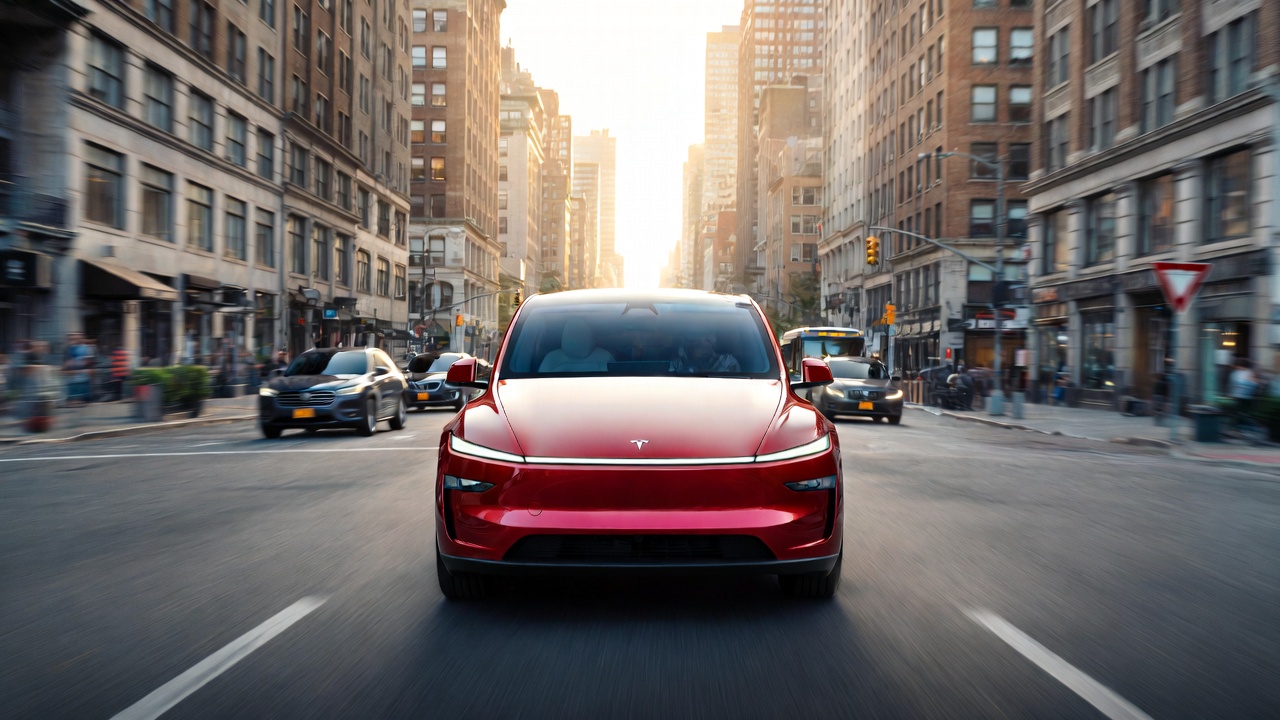
Tesla’s Full Self-Driving (Supervised) fleet is closing in on almost 7 billion total miles driven, as per data posted by the company on its official FSD webpage.
These figures hint at the massive scale of data fueling Tesla’s rapid FSD improvements, which have been quite notable as of late.
FSD mileage milestones
As can be seen on Tesla’s official FSD webpage, vehicles equipped with the system have now navigated over 6.99 billion miles. Tesla owner and avid FSD tester Whole Mars Catalog also shared a screenshot indicating that from the nearly 7 billion miles traveled by the FSD fleet, more than 2.5 billion miles were driven inside cities.
City miles are particularly valuable for complex urban scenarios like unprotected turns, pedestrian interactions, and traffic lights. This is also the difference-maker for FSD, as only complex solutions, such as Waymo’s self-driving taxis, operate similarly on inner-city streets. And even then, incidents such as the San Francisco blackouts have proven challenging for sensor-rich vehicles like Waymos.
Tesla’s data edge
Tesla has a number of advantages in the autonomous vehicle sector, one of which is the size of its fleet and the number of vehicles training FSD on real-world roads. Tesla’s nearly 7 billion FSD miles then allow the company to roll out updates that make its vehicles behave like they are being driven by experienced drivers, even if they are operating on their own.
So notable are Tesla’s improvements to FSD that NVIDIA Director of Robotics Jim Fan, after experiencing FSD v14, noted that the system is the first AI that passes what he described as a “Physical Turing Test.”
“Despite knowing exactly how robot learning works, I still find it magical watching the steering wheel turn by itself. First it feels surreal, next it becomes routine. Then, like the smartphone, taking it away actively hurts. This is how humanity gets rewired and glued to god-like technologies,” Fan wrote in a post on X.
News
Tesla starts showing how FSD will change lives in Europe
Local officials tested the system on narrow country roads and were impressed by FSD’s smooth, human-like driving, with some calling the service a game-changer for everyday life in areas that are far from urban centers.
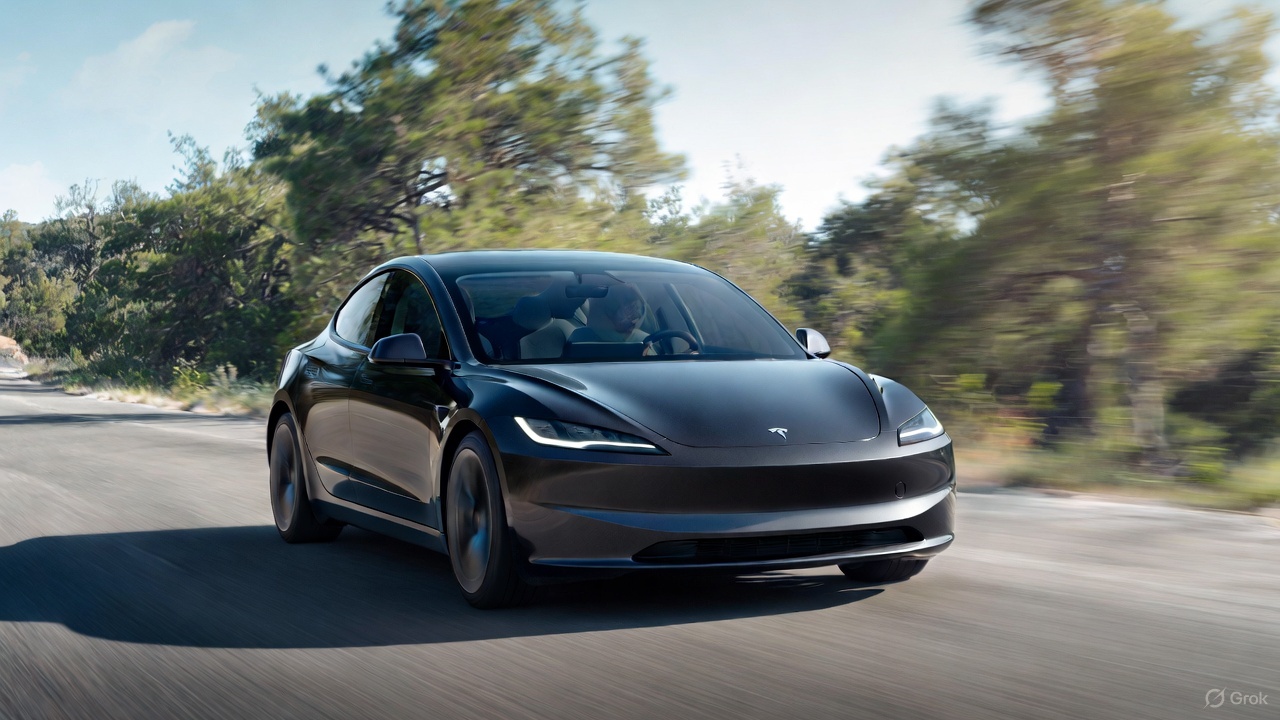
Tesla has launched Europe’s first public shuttle service using Full Self-Driving (Supervised) in the rural Eifelkreis Bitburg-Prüm region of Germany, demonstrating how the technology can restore independence and mobility for people who struggle with limited transport options.
Local officials tested the system on narrow country roads and were impressed by FSD’s smooth, human-like driving, with some calling the service a game-changer for everyday life in areas that are far from urban centers.
Officials see real impact on rural residents
Arzfeld Mayor Johannes Kuhl and District Administrator Andreas Kruppert personally tested the Tesla shuttle service. This allowed them to see just how well FSD navigated winding lanes and rural roads confidently. Kruppert said, “Autonomous driving sounds like science fiction to many, but we simply see here that it works totally well in rural regions too.” Kuhl, for his part, also noted that FSD “feels like a very experienced driver.”
The pilot complements the area’s “Citizen Bus” program, which provides on-demand rides for elderly residents who can no longer drive themselves. Tesla Europe shared a video of a demonstration of the service, highlighting how FSD gives people their freedom back, even in places where public transport is not as prevalent.
What the Ministry for Economic Affairs and Transport says
Rhineland-Palatinate’s Minister Daniela Schmitt supported the project, praising the collaboration that made this “first of its kind in Europe” possible. As per the ministry, the rural rollout for the service shows FSD’s potential beyond major cities, and it delivers tangible benefits like grocery runs, doctor visits, and social connections for isolated residents.
“Reliable and flexible mobility is especially vital in rural areas. With the launch of a shuttle service using self-driving vehicles (FSD supervised) by Tesla in the Eifelkreis Bitburg-Prüm, an innovative pilot project is now getting underway that complements local community bus services. It is the first project of its kind in Europe.
“The result is a real gain for rural mobility: greater accessibility, more flexibility and tangible benefits for everyday life. A strong signal for innovation, cooperation and future-oriented mobility beyond urban centers,” the ministry wrote in a LinkedIn post.
News
Tesla China quietly posts Robotaxi-related job listing
Tesla China is currently seeking a Low Voltage Electrical Engineer to work on circuit board design for the company’s autonomous vehicles.

Tesla has posted a new job listing in Shanghai explicitly tied to its Robotaxi program, fueling speculation that the company is preparing to launch its dedicated autonomous ride-hailing service in China.
As noted in the listing, Tesla China is currently seeking a Low Voltage Electrical Engineer to work on circuit board design for the company’s autonomous vehicles.
Robotaxi-specific role
The listing, which was shared on social media platform X by industry watcher @tslaming, suggested that Tesla China is looking to fill the role urgently. The job listing itself specifically mentions that the person hired for the role will be working on the Low Voltage Hardware team, which would design the circuit boards that would serve as the nervous system of the Robotaxi.
Key tasks for the role, as indicated in the job listing, include collaboration with PCB layout, firmware, mechanical, program management, and validation teams, among other responsibilities. The role is based in Shanghai.
China Robotaxi launch
China represents a massive potential market for robotaxis, with its dense urban centers and supportive policies in select cities. Tesla has limited permission to roll out FSD in the country, though despite this, its vehicles have been hailed as among the best in the market when it comes to autonomous features. So far, at least, it appears that China supports Tesla’s FSD and Robotaxi rollout.
This was hinted at in November, when Tesla brought the Cybercab to the 8th China International Import Expo (CIIE) in Shanghai, marking the first time that the autonomous two-seater was brought to the Asia-Pacific region. The vehicle, despite not having a release date in China, received a significant amount of interest among the event’s attendees.
